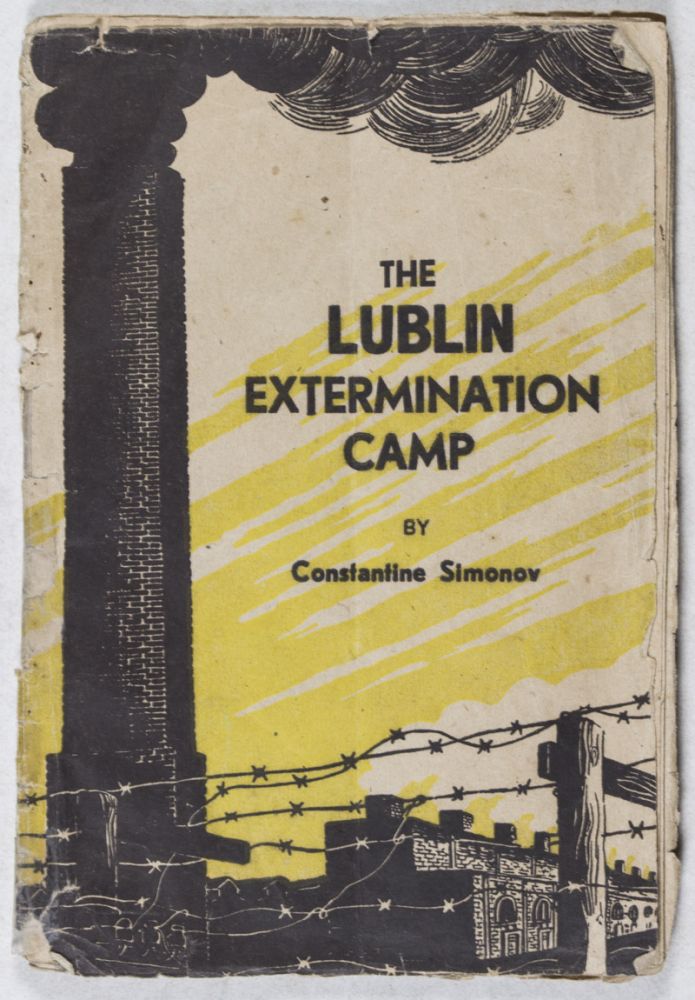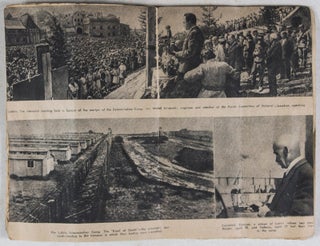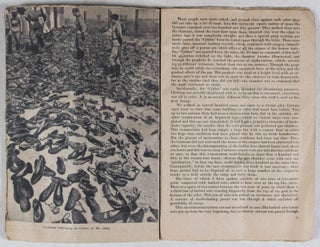The Lublin Extermination Camp
Moscow: Foreign Languages Publishing House, 1944. First edition. Softcover. Octavo (5 7/8 x 8 1/2"). 21, [5]pp. Original illustrated wrappers. Published on September 24, 1944, this work is the first report on the Lublin extermination camp (Majdanek*). It was written by Konstantin Simonov, a Soviet writer and journalist who was with the Red Army when it liberated the camp in July 1944. The report was originally serialized in the Red Army newspaper "Krasnaia zvezda" (Red Star) over three issues in August 1944, and then broadcasted on the radio during three consecutive evenings. Prior to the appearance of Konstantin Simonov’s newspaper account, there were some eyewitness accounts by escaped prisoners, such as “The Vrba-Wetzler Report” about Auschwitz, but they were not published in full. This booklet contains 13 b/w photographic reproductions. Some creasing, foxing and chipping along edges of wrappers. Pages 5 to 20 disbound, but present. Age-toning and folding mark throughout. Wrappers and interior in overall fair condition. f. Item #39205
* "Majdanek or KL Lublin was a Nazi German concentration and extermination camp established on the outskirts of the city of Lublin during the German occupation of Poland in World War II. Although initially purposed for forced labor rather than extermination, the camp was used to kill people on an industrial scale during Operation Reinhard, the German plan to murder all Jews within their General Government territory of Poland. The camp, which operated from October 1, 1941 until July 22, 1944, was captured nearly intact, because the rapid advance of the Soviet Red Army during Operation Bagration prevented the SS from destroying most of its infrastructure; but also, due to the ineptitude of commandant Anton Thernes who failed in his task of removing incriminating evidence of war crimes. Majdanek, also known to the SS as Konzentrationslager Lublin, remains the best preserved Nazi concentration camp of the Holocaust. Unlike other similar camps in Nazi occupied Poland, Majdanek was not located in a remote rural location away from population centres, but within the boundaries of a major city. This proximity led the camp to be named 'Majdanek' ("little Majdan") by local people in 1941 because it was adjacent to the city's district of Majdan Tatarski ("Tatar Maidan") in Lublin. The total number of victims is controversial, beginning with the research of Judge Zdzislaw Lukaszkiewicz dating back to 1948, who gave the figure of 360,000 victims. It was followed by estimation of around 235,000 victims by Dr. Czeslaw Rajca (1992) from the Majdanek Museum, which was cited by the museum for years. The most recent figure (78,000) was given in 2005 by Tomasz Kranz, director of the Research Department of the State Museum at Majdanek. That number is close to the one currently indicated on the museum's website. It is considered "incredibly low" by now retired Dr. Rajca, nevertheless it has been accepted by the Museum Board of Directors "with a certain caution", pending further research into the number of prisoners who were not entered into the Holocaust train records by German camp administration which is a known fact. For now, the Museum informs that based on new research, some 150,000 prisoners arrived at Majdanek during the 34 months of its existence. Of the more than 2,000,000 Jewish people killed in the course of Operation Reinhard, some 60,000 Jews (56,000 known by name) were most certainly exterminated at Majdanek, amongst its almost 80,000 victims accounted for, altogether" (from Wikipedia).
Price: $450.00



